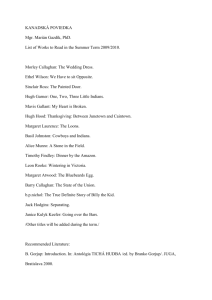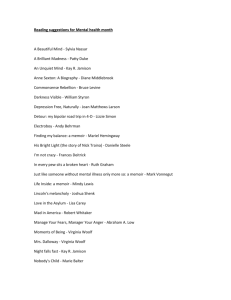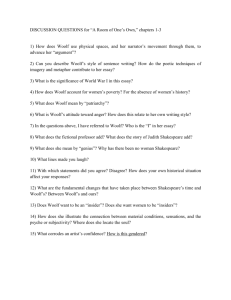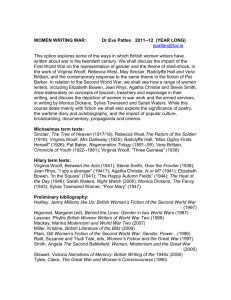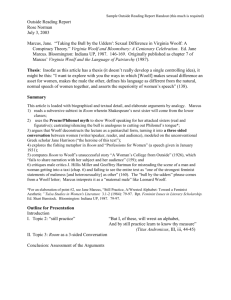my piece - WordPress.com
advertisement
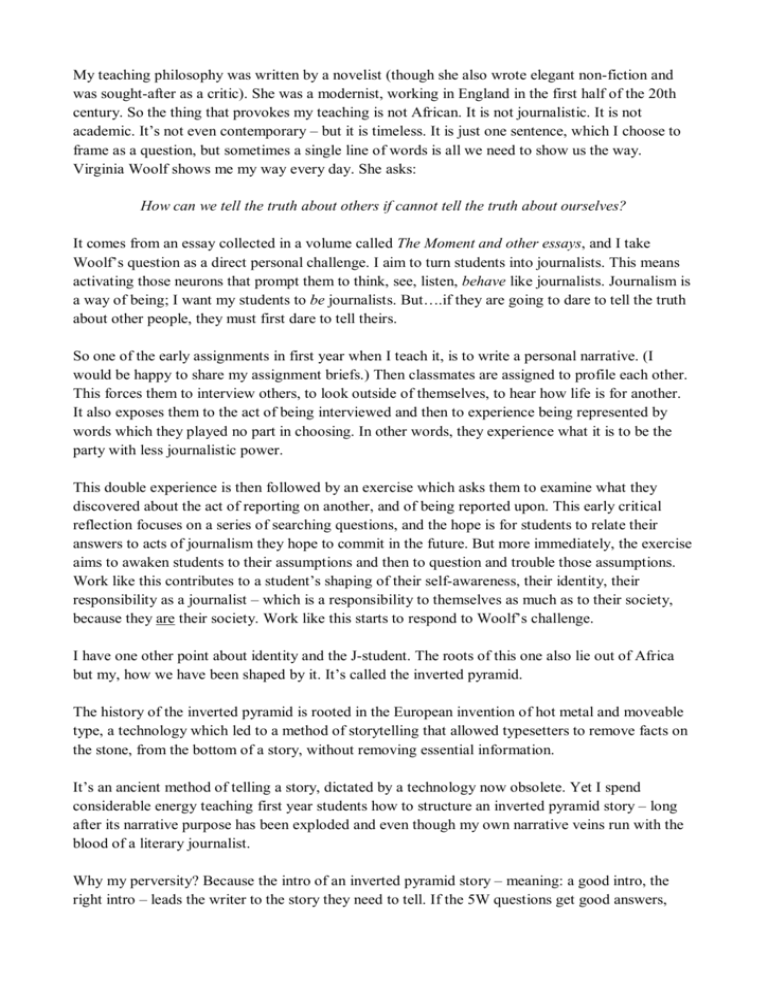
My teaching philosophy was written by a novelist (though she also wrote elegant non-fiction and was sought-after as a critic). She was a modernist, working in England in the first half of the 20th century. So the thing that provokes my teaching is not African. It is not journalistic. It is not academic. It’s not even contemporary – but it is timeless. It is just one sentence, which I choose to frame as a question, but sometimes a single line of words is all we need to show us the way. Virginia Woolf shows me my way every day. She asks: How can we tell the truth about others if cannot tell the truth about ourselves? It comes from an essay collected in a volume called The Moment and other essays, and I take Woolf’s question as a direct personal challenge. I aim to turn students into journalists. This means activating those neurons that prompt them to think, see, listen, behave like journalists. Journalism is a way of being; I want my students to be journalists. But….if they are going to dare to tell the truth about other people, they must first dare to tell theirs. So one of the early assignments in first year when I teach it, is to write a personal narrative. (I would be happy to share my assignment briefs.) Then classmates are assigned to profile each other. This forces them to interview others, to look outside of themselves, to hear how life is for another. It also exposes them to the act of being interviewed and then to experience being represented by words which they played no part in choosing. In other words, they experience what it is to be the party with less journalistic power. This double experience is then followed by an exercise which asks them to examine what they discovered about the act of reporting on another, and of being reported upon. This early critical reflection focuses on a series of searching questions, and the hope is for students to relate their answers to acts of journalism they hope to commit in the future. But more immediately, the exercise aims to awaken students to their assumptions and then to question and trouble those assumptions. Work like this contributes to a student’s shaping of their self-awareness, their identity, their responsibility as a journalist – which is a responsibility to themselves as much as to their society, because they are their society. Work like this starts to respond to Woolf’s challenge. I have one other point about identity and the J-student. The roots of this one also lie out of Africa but my, how we have been shaped by it. It’s called the inverted pyramid. The history of the inverted pyramid is rooted in the European invention of hot metal and moveable type, a technology which led to a method of storytelling that allowed typesetters to remove facts on the stone, from the bottom of a story, without removing essential information. It’s an ancient method of telling a story, dictated by a technology now obsolete. Yet I spend considerable energy teaching first year students how to structure an inverted pyramid story – long after its narrative purpose has been exploded and even though my own narrative veins run with the blood of a literary journalist. Why my perversity? Because the intro of an inverted pyramid story – meaning: a good intro, the right intro – leads the writer to the story they need to tell. If the 5W questions get good answers, readers get good stories. But, and here whispers the spirit of Virginia Woolf, the way you answer your Ws reflects who you are and what you make of your society. So teaching the inverted pyramid allows me to approach several important journalistic matters: Know what the story is (journalism trainer Gwen Ansell has recommended – more recently than the 19th century – that reporters can fasten onto their story by creating a hypothetical text message, a tactic which has a similar outcome to an inverted pyramid intro but which could risk omitting some crucial Ws) Who you are dictates how you live in the world and therefore what your story will be. Which brings me to… Gatekeeping, an outdated term but nevertheless a useful one for the conscious and unconscious filtering that drives the editorial decision-making process of constructing news. Which brings me to: News construction, which comes as an alarming surprise to many first year J-students who take news to be a natural phenomenon. And, finally: How you tell a story has the potential to change the world, or at least the way we see it. Woolf did that for the western world. The basis of her work? Words. Words with meaning, words selected by an individual, and therefore words with a particular meaning. If, as a reporter, she had not known the truth of who she was, could she have told us the truth about who others are, the truth about ourselves? To close, I summon another non-African non-journalist non-academic. Margaret Atwood may be Canadian and she may be a novelist but, just as Woolf did, Atwood also writes elegant non-fiction and is a fine critic. This line, however, comes from a poem. It is not a question but it is a provocation. With it, I hear Atwood speaking directly to journalists in Southern Africa when she says: A word after a word after a word is power. Sometimes, a short row of words is all we need to show us the way. A word after a word / after a word is power. - Margaret Atwood in ‘Spelling’ If you do not tell the truth about yourself you cannot tell it about other people. - Virginia Woolf in ‘The Moment and other essays’ A word after a word / after a word is power. - Margaret Atwood in ‘Spelling’ If you do not tell the truth about yourself you cannot tell it about other people. - Virginia Woolf in ‘The Moment and other essays’ A word after a word / after a word is power. - Margaret Atwood in ‘Spelling’ If you do not tell the truth about yourself you cannot tell it about other people. - Virginia Woolf in ‘The Moment and other essays’ A word after a word / after a word is power. - Margaret Atwood in ‘Spelling’ If you do not tell the truth about yourself you cannot tell it about other people. - Virginia Woolf in ‘The Moment and other essays’ A word after a word / after a word is power. - Margaret Atwood in ‘Spelling’ If you do not tell the truth about yourself you cannot tell it about other people. - Virginia Woolf in ‘The Moment and other essays’ Questions to ponder before this week’s tutorial About your personal narrative: 1. 2. 3. 4. 5. How easy or difficult was it to isolate an event on which to base your narrative? What made it easy / difficult? What do you think your reader felt about you as a result of reading your personal narrative? Did you want them to feel this way? In the telling of your story, were you absolutely truthful? Is your account an accurate version of what really happened? 6. How important is it to be absolutely truthful and accurate? 7. Bearing in mind what you have learnt from previous tutorials about representing the self, reflect now upon your own experience of representing yourself in your personal narrative. What comes to mind? About your profile: 1. 2. 3. 4. 5. 6. 7. What aspect of your subject did you choose to represent in your profile assignment? What helped you arrive at that decision? How did you convey this aspect to the reader? Is your profile an absolutely accurate representation of your subject? Explain your answer. Would your subject recognise herself/himself in your profile? Explain your answer. Do you relish the moment your subject reads your profile? Expand on your answer. Taking yourself back to the interview, mentally switch places with your subject. Observe yourself asking questions, listening, taking notes, making connections, making assumptions, drawing conclusions. What do you see?
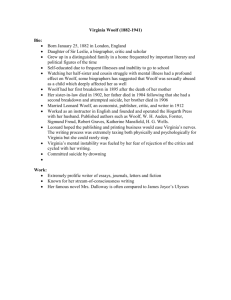
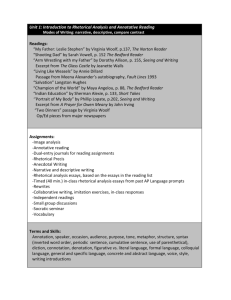
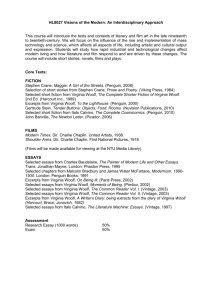
![Special Author: Woolf [DOCX 360.06KB]](http://s3.studylib.net/store/data/006596973_1-e40a8ca5d1b3c6087fa6387124828409-300x300.png)
